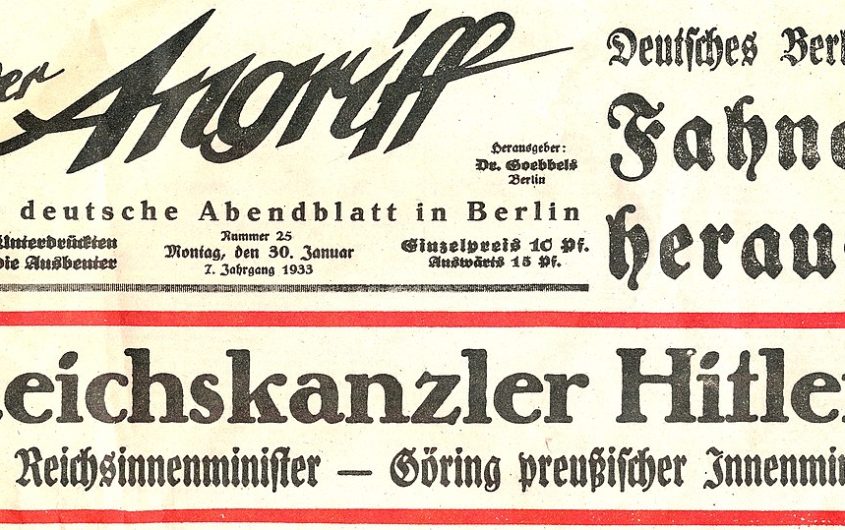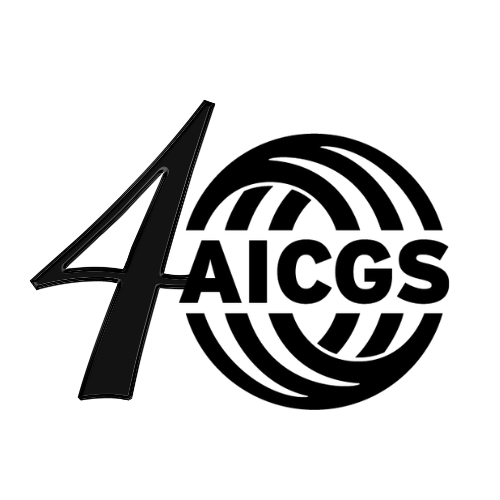
Mabit1 via Wikimedia Commons
The Not-so-Sudden Death of Weimar Democracy

Anna von der Goltz
Georgetown University
Anna von der Goltz teaches German and European History in Georgetown University's School of Foreign Service and Department of History. Her research focuses on the political and cultural history of twentieth century Germany. She is the author of Hindenburg: Power, Myth and the Rise of the Nazis (Oxford UP, 2009), which won the Fraenkel Prize in Contemporary History, and of The Other '68ers: Student Protest and Christian Democracy (Oxford UP, 2021.)
January 30, 1933, the day that Reich President Paul von Hindenburg appointed the Nazi leader Adolf Hitler as chancellor of Germany—and a day whose 90th anniversary we marked last month—was undoubtedly a fateful moment in German (and in global) history. The Nazis had been the largest party in the Reichstag since the national elections of July 1932, making it politically impossible to form a cabinet with a parliamentary majority without them. However, throughout the second half of 1932, Hindenburg, who harbored personal and political reservations about the ‘Bohemian corporal,’ repeatedly refused to give in to Hitler’s demands for the top job. Instead, the country continued to be governed by a presidential cabinet under the authoritarian Center Party politician Franz von Papen that derived its legitimacy entirely from the emergency powers granted to the president by Article 48 of the Weimar constitution. Facing growing public pressure when Papen had still not managed to form a majority by December, Hindenburg replaced him with his longtime confidant Kurt von Schleicher, who hoped to form a parliamentary majority by splitting the NSDAP. When that plan failed, Hitler’s appointment to the Chancellery began to look like the only viable alternative to establishing a military dictatorship. Hindenburg and his circle were concerned about a looming civil war in which the Reichswehr would be outnumbered by Nazi stormtroopers and armed supporters of the Communists and Social Democrats. Ultimately, Hindenburg was convinced that, even as chancellor, Hitler would be dependent on his presidential authority and could be kept in check—and that his appointment would safeguard the president’s reputation as a symbol of constitutional governance and national unity.
After several weeks of intense behind-the-scenes negotiations, Hitler finally became Chancellor on January 30, 1933. In his new cabinet of ‘national concentration,’ three Nazis were ‘fenced in’ by nine conservatives. Crucially, however, the Nazi leader had behind him a dynamic mass party with a paramilitary wing comprising hundreds of thousands of members. Over the next weeks and months, the remaining constitutional checks and balances on executive power were overturned, and the Nazis’ political opponents, Jewish Germans, and other minorities were subjected to a campaign of intimidation and increasingly violent terror. The last remnants of Weimar democracy were dismantled; Germany became a dictatorship that would last until the country’s military defeat in 1945.
January 30, 1933, was a major turning point, and it is worth holding up this day as a warning. Focusing interpretations of the Nazis’ rise to power and the end of Weimar democracy on this date throws into sharp relief the dangers that arise when political elites fail to act, as Steven Levitsky and Daniel Ziblatt explained in their book How Democracies Die, as ‘gatekeepers’ of democracy by doing everything in their power to keep extremists out of government.
But honing in on this date potentially also narrows our field of vision. From this vantage point, the end of Weimar democracy appears primarily as the result of the flawed (and likely preventable) decisions made by a relatively small group of men—notably Papen, Schleicher, and the aging Hindenburg and his advisers (the famed ‘camarilla’)—about which the German public was kept in the dark. Hitler’s appointment can even appear like a ‘historical accident’ without any notable links to the rest of German history. This was the dominant (West) German narrative in the first postwar decades, visualized in a famous photograph disseminated in countless illustrated publications, school textbooks, and encyclopedias. Taken on the “Day of Potsdam” on March 20, 1933, it showed Hindenburg and a bowing Hitler shaking hands. The photograph blanked out the audience and focused entirely on these two men, thereby personalizing responsibility. Because post-war observers were aware that Hitler’s actions that followed made a mockery of his posture as the humble servant, the image also highlighted the Nazis’ hypocrisy and powers of seduction. Hindenburg—symbolizing the gullibility of the (doubly) old elites—had been conned by the Nazi leader and delivered Germany to the Nazis almost single-handedly, it suggested. Tellingly, for all its emphasis on structural determinants, the official narrative in socialist East Germany also singled out Hindenburg as a symbol of the culpability of the capitalist and militarist elites: the Prussian Junker with a vast estate, whose family had faced allegations of corruption, was ultimately responsible for Hitler’s appointment. Although conceived of in very different political systems, the memory strategies in postwar East and West Germany overlapped to a surprisingly high degree in their self-exculpatory thrust.
Focusing interpretations of the Nazis’ rise to power and the end of Weimar democracy on this date throws into sharp relief the dangers that arise when political elites fail to act.
To avoid overly personalized readings of why the Nazis came to power and the self-exculpatory tendencies that have often gone hand in hand with these, we also need to remember that the backroom deals that led to January 30, sinister and consequential though they may have been, were embedded in a much longer process of democratic dissolution and the rise of authoritarian politics. Weimar’s collapse and the rise of the Nazis cannot be reduced to one date alone or to the actions of a handful of people. There were many other critical moments in the years before 1933: the end of the grand coalition government and Heinrich Brüning’s appointment as head of the first presidential cabinet in April 1930; the Nazis’ electoral breakthrough in 1930 and their decisive victory in July 1932; or the dismissal of the Social Democrat Otto Braun and the dissolution of the Prussian government, the last state government comprised of the pro-Weimar parties in July 1932. Focusing on these accentuates a different set of issues: the anti-Socialist reflex of bourgeois and conservative politicians that helped to sideline the Social Democrats, the main defenders of the republic; the widespread distrust of parliamentary democracy that had only grown since the economic crisis of 1929/30; the considerable popular support enjoyed by the Nazis, who never garnered a majority of the vote in free elections, but who were nevertheless the largest party in July 1932 and, despite some significant losses, again in November 1932.
Nor did history end on January 30. Nazi rule was not yet firmly secured with Hitler’s appointment; Germany did not turn into a dictatorship overnight. Its consolidation required multiple additional steps: a campaign of violence and intimidation against the Nazis’ political opponents and those deemed racially inferior—above all, the Jews—; the Reichstag fire; the March elections of 1933; the passing of the Enabling Act, which only the Social Democratic Reichstag deputies opposed (the Communists were barred from participating in the vote); numerous carefully choreographed public displays that celebrated the Volksgemeinschaft and increasingly bound ordinary Germans to the regime; the murderous purge of June 1934; and Hindenburg’s continuous backing of the Nazi project, which was far from accidental and which only grew after January 1933, culminating in a political will published after his death in August 1934 that embraced the Führer as his only worthy successor.
Broadening our field of vision beyond January 30, 1933, emphasizes that lessons about the failure of political elites, accidental choices, or flawed individual leaders are not the only ones to be drawn from this history. Yes, sound decision-making matters and politicians who take their roles seriously as gatekeepers of democracy are sorely needed; a lot of damage can be done by a few people in backrooms while the public is not watching. But democracies do not die suddenly, overnight. Democracies, including the Weimar Republic, die a slower death. Amongst other things, they require vibrant parties, strong democratic norms and institutions, an active civil society, a shared perception of political reality and a functioning press, and an everyday lived commitment to political pluralism and minority rights. All of these things are needed to ensure that democracy does not just survive another day, but thrives. These are lessons citizens on both sides of the Atlantic would do well to heed in 2023 and beyond.
 This article is part of the Society, Culture & Politics Program’s AGI 40th anniversary series.
This article is part of the Society, Culture & Politics Program’s AGI 40th anniversary series.









